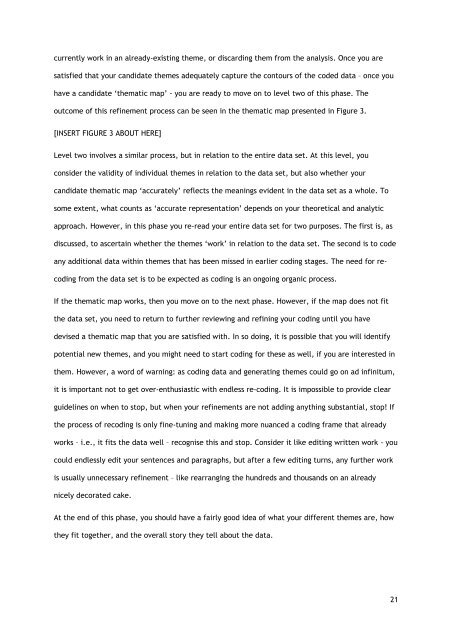Braun, V. and Clarke, V. - UWE Research Repository - University of ...
Braun, V. and Clarke, V. - UWE Research Repository - University of ...
Braun, V. and Clarke, V. - UWE Research Repository - University of ...
You also want an ePaper? Increase the reach of your titles
YUMPU automatically turns print PDFs into web optimized ePapers that Google loves.
currently work in an already-existing theme, or discarding them from the analysis. Once you are<br />
satisfied that your c<strong>and</strong>idate themes adequately capture the contours <strong>of</strong> the coded data – once you<br />
have a c<strong>and</strong>idate „thematic map‟ - you are ready to move on to level two <strong>of</strong> this phase. The<br />
outcome <strong>of</strong> this refinement process can be seen in the thematic map presented in Figure 3.<br />
[INSERT FIGURE 3 ABOUT HERE]<br />
Level two involves a similar process, but in relation to the entire data set. At this level, you<br />
consider the validity <strong>of</strong> individual themes in relation to the data set, but also whether your<br />
c<strong>and</strong>idate thematic map „accurately‟ reflects the meanings evident in the data set as a whole. To<br />
some extent, what counts as „accurate representation‟ depends on your theoretical <strong>and</strong> analytic<br />
approach. However, in this phase you re-read your entire data set for two purposes. The first is, as<br />
discussed, to ascertain whether the themes „work‟ in relation to the data set. The second is to code<br />
any additional data within themes that has been missed in earlier coding stages. The need for re-<br />
coding from the data set is to be expected as coding is an ongoing organic process.<br />
If the thematic map works, then you move on to the next phase. However, if the map does not fit<br />
the data set, you need to return to further reviewing <strong>and</strong> refining your coding until you have<br />
devised a thematic map that you are satisfied with. In so doing, it is possible that you will identify<br />
potential new themes, <strong>and</strong> you might need to start coding for these as well, if you are interested in<br />
them. However, a word <strong>of</strong> warning: as coding data <strong>and</strong> generating themes could go on ad infinitum,<br />
it is important not to get over-enthusiastic with endless re-coding. It is impossible to provide clear<br />
guidelines on when to stop, but when your refinements are not adding anything substantial, stop! If<br />
the process <strong>of</strong> recoding is only fine-tuning <strong>and</strong> making more nuanced a coding frame that already<br />
works – i.e., it fits the data well – recognise this <strong>and</strong> stop. Consider it like editing written work - you<br />
could endlessly edit your sentences <strong>and</strong> paragraphs, but after a few editing turns, any further work<br />
is usually unnecessary refinement – like rearranging the hundreds <strong>and</strong> thous<strong>and</strong>s on an already<br />
nicely decorated cake.<br />
At the end <strong>of</strong> this phase, you should have a fairly good idea <strong>of</strong> what your different themes are, how<br />
they fit together, <strong>and</strong> the overall story they tell about the data.<br />
21

















